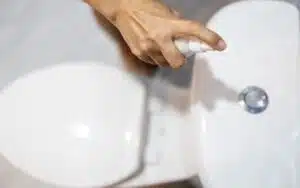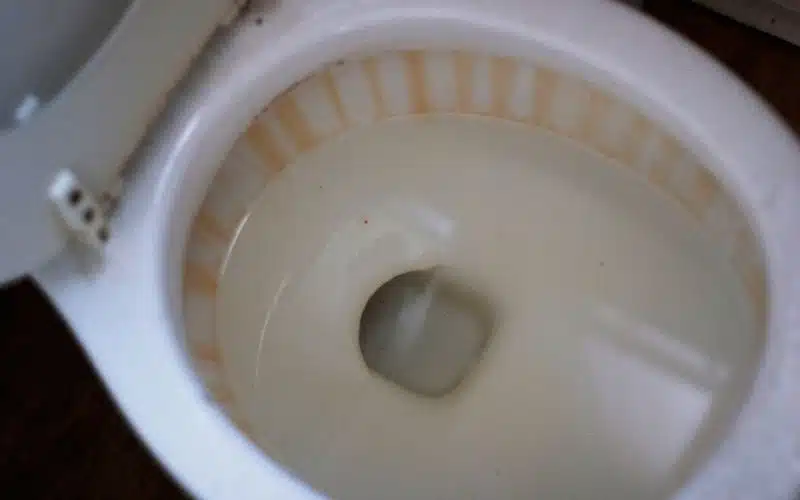Almost everyone who uses water closet toilets can testify at some point that they have seen cracks on their toilet seats.
Ranging from hairline-like cracks to bigger ones. While many people ignore this, it worries the remaining percentage about why this is so and how they can fix it.
Mostly, toilet seats crack because of the wrong usage, and sometimes, the materials are used to build or install the toilet. While glue and tape have been many people’s go-to options for a toilet seat crack, you can always do better.
Why Do Toilet Seats Crack?

Several reasons your toilet seats may begin to crack or have crack lines. Examples of such situations include:
#1. Excess Weight on the Toilet Seat
Originally, toilets were designed to carry around 500 to 1000 pounds. Also, this design is not restricted to toilets mounted to the floor alone. Even wall-mounted toilets can carry this amount of weight.
However, the issue sprouts when you place more than the expected weight on the toilet seat.
If you weigh extra, you can always opt for getting your toilet seat designed especially for you. This may cost more than usual, but it will save you the stress of always fixing a toilet.
Aside from being overweight, your toilet seat will crack if you always lean in a particular direction. This situation is most common among stroke patients but not rare among people.
If you’re the type to always sit on only one end of your toilet, you’ll need extra money to change your toilet permanently.
#2. Type of Material Used in Building the Toilet
If you notice your toilet cracking and you’re not overweight or guilty of sitting on one side, check the material used to build the toilet.
Make inquiries from the manufacturers using either their websites or customer care line. You can check the toilet for logos and company names if you do not know your toilet manufacturers.
Alternatively, you can look up what features a poorly built toilet has (on the internet) and compare it with your toilet.
The best toilets (ceramics) are built using items like:
- Vitreous clay (the primary material used in producing ceramic toilets).
- Silica.
- Fluxing agents.
How Do I fix a Cracked Toilet Seat?
Problems will only bother you for as long as you do not attend to them or try to find a lasting solution.
So if you’re wondering whether or not you can fix your cracked toilet seat, the answer is yes. You can also do this personally or seek professional aid.
For the first fixing method, you’ll need a few tools and items like:
- Epoxy glue. Two-part glues are most preferably like the Gorilla 2 glue.
- Old newspapers.
- Cleaning detergent.
- Sponge.
- Cleaning gloves.
- If you use wooden toilets, then you also need wood glue.
#1. Step 1: Detach the Toilet Seat From the Bowl
Before fixing your cracked toilet seat, you must detach the toilet seat from the bowl the builders fixed it in. This makes the whole process easier for you or whoever is fixing the toilet.
#2. Step 2: Clean
Secondly, use your sponge, gloves, and cleaning detergent to clean the toilet seat properly. Finally, get rid of stains and other things that need to be cleaned from the toilet.
At this point, you do not need to do any cleaning with abrasives or a stiff brush. Mainly because you do not want to worsen the cracks on the toilet already.
#3. Step 3: Fix
Now, to fix the cracks, you’ll have to do differently for wooden and plastic toilet seats, respectively.
#1. Wooden Toilet Seats
For repairing the wooden seats, follow the below-listed steps.
- Gently pry the toilet seat crack, allowing you to pour in the glue. You should go for glue with a nozzle, so pouring in will be easier.
- Ensure you fill the entire crack with glue.
- And the newspaper such that it fills the gap left in the crack.
Alternatively, you can easily use a bar clamp to combine the two parts of the toilet. It’ll meet the glue and fix the crack.
#2. Plastic Seats
For plastic toilet seats, you’re to use epoxy glue. The steps for fixing cracks on a Plastic toilet are pretty straightforward. They are:
- Mix the glue properly.
- Spread it properly and evenly and ensure the glue sticks into the crack.
- Use a bar clamp to bring together the cracked area of the toilet and leave the glue to dry overnight.
Note: While fixing the toilet, you shouldn’t use the toilet for any activities, so you don’t soil the work. Also, ensure the toilet seat is dry and remains dry throughout the fixing process.
#3. Ceramic Toilets
These measures may not be the most effective for ceramic toilets (which are the most common).
For example, if you notice your ceramic toilet seat has hairline cracks, then it is best to fill it up with glue so that the cracks don’t expand.
For more significant cracks, call a professional to either fix them or change the toilet seat. However, it is recommended that you change the toilet seat instead.
Can You Still Use a Cracked Toilet Seat?
Using your toilet seat even after it has cracked is possible. But while this is possible and widely practiced, it is not advisable.
This is because you face a few disadvantages when using your toilet seats after they are cracked. You stand a risk of:
#1. Wounds and Blisters
It is not rare for you to get injured from using a cracked toilet. For example, you will experience blisters on your thighs or buttocks if you do not get actual cuts.
#2. Insects Living in the Cracks
Termites are known to infest any place they get a small opportunity to. But not just termites. Other little insects can take shelter in those cracks and sting you.
This infestation is more familiar with ceramic toilets since they’re made of clay.
While adults may be able to control themselves and be careful of the rate of wounds/ injuries and bites they get from the cracks, children cannot.
Therefore, you shouldn’t let your kids or any child around you use cracked toilets. At least not until you have fixed the issue or changed the toilet seat.
How Often Do Toilet Seats Crack?
Toilet seat cracks are not unusual. Therefore, 6 of 10 toilets in the same neighborhood may crack after installation.
The time frame for this to take place is usually 5 to 7 years after the toilet is built. As often as you put excess weight on your toilet seat and use abrasives, it stands a chance of cracking.
You can always avoid cracking your toilet seats by:
- Do not install shelves with heavy objects just above your toilet seat. This safety measure prevents objects from falling and breaking into the toilet.
- You should use items like hair dryers and stretchers far away from the toilet seat. Since accidents cannot be known before they happen, you should avoid them.
- Make sure you always clean your toilet and ensure it is always dry. For example, if your toilet seat is always wet, the materials used in building the toilet are more likely to react. As a result, there may be wear which eventually leads to cracks.
What is the Best Glue For Toilet Seats?
While listing how to fix cracks on toilet seats, we mentioned using glue. However, using glue doesn’t mean that just any kind of glue will do the job perfectly.
Below is a list of some of the best glue types you can use to fix cracks on your toilet seat.
Ensure to read the product instructions before you use any of them.
Conclusion
In conclusion, avoid any circumstances resulting in a cracked toilet seat. However, if you notice the cracks early enough, do not ignore them. Instead, ensure you fix the issue on time to avoid further deterioration.
- Can You Flush Alcohol Down the Toilet? (Read Before)
- Are Padded Toilet Seats Sanitary Or Unsanitary? (Must Know)
- Is It Safe To Put Antifreeze in Toilets? (Read This First)
- Does Bleach & Vinegar Dissolve Toilet Paper? (Read This)
- Orange Ring in Toilet Bowl? (Causes, Fixes & More)
- How To Get Rid Of Blue Toilet Water? (This Trick Works)











